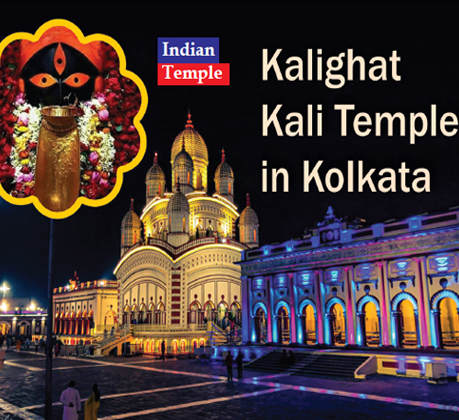Hinduism is one of the oldest religions in the world and the largest religion in India. Goddess Kali is an incarnation of Shakti, the principal female divinity of Hinduism. Hence, you will find Kali temples strewn across the length and
breadth of India. However, only a handful of them can match up to the Kalighat Temple in repute. According to Hindu mythology, when Lord Shiva performed his destructive dance, taandav, with Goddess Sati in his arms, after she had sacrificed
herself, Sati’s body dismembered into 51 parts that fell off the sky. It is said that the places where the body parts fell, became sacred places of worship of Shakti and came to be known as Shakti Peethas. The Kalighat Temple is one among
the 51 Shakti Peethas and the legend has it that one of the Goddess right toes fell at the place on the bank of the Adi Ganga river canal where the temple stands today. With its pride of place in people’s beliefs and unique heritage, the
Kalighat Kali Temple is a must-visit on your trip to Kolkata, the City of Joy.
However, the Kalighat Temple has been referenced many times in the 15th and 17th-century Hindu religious scriptures. It might be because Raja Basanta Roy, the king of Jessore (presently in Bangladesh), had built a temple at the same
location which was a layover on an important trade route. The same temple attained the status of a Shakti Peeth and was revamped more than two centuries ago. You will be fascinated to know that coins from the Gupta period (319-543 CE) have
also been unearthed from the region. So, as you can see, the history of the temple has been mired in folklores and controversies that have only contributed to the enigma of the temple.
The foggy history of the Kalighat Kali Temple
The Kalighat Temple is ensconced in a web of myths. It is popularly believed that two saints, Brahmananda and Atmaram Giri, discovered the fossil of one of Goddess Sati’s right toes from Kalikunda, a pond in the area. This discovery gave
Kalighat the recognition as a Shakti Peeth. In 1809, Sabarna Roy Choudhury, the Zamindar (landowner) of the region, gave 595 bighas of land to built the temple complex that stands today in the bustling south Kolkata neighbourhood. Kalighat
temple has references in 15th century texts.
The original temple was a small hut. It is believed by some scholars that the name Calcutta was derived from Kalighat. Historically, traders halted at Kalighat to pay patronage to the goddess.
The temple was initially on the banks of Hoogly. The river over a period of time has moved away from the temple. The temple is now on the banks of a small canal called Adi Ganga, connecting to Hooghly.
Around the Kalighat Kali Temple
The Kalighat Kali Temple has a sanctum sanctorum which is a single dome structure. The image of Kali in this temple is unique. Inside this structure resides the idol of the famed mother goddess Kali has three huge eyes with a long protruded
tongue and four hands are made of pure gold. Out of the four hands, the top left hand holds a Kharga or a Scimitar, the bottom left holds a severed head of the Asura King Shumbha, while the top right hand she shows the Abhay Mudra, and the
bottom right hands she shows the Varada Mudra. Whilst the Scimitar signifies Divine Knowledge, the severed head of the Asura signifies the human Ego which has to be slain by the Divine Knowledge to attain Moksha or one’s goal in life. The
Abhay Mudra signifies that the Goddess is always there with her devotees, protecting them from harm, while the Varada Mudra shows the benevolence and the soft-heartedness of the Devi, showering her devotees with divine and material
blessings.
This structure is accompanied by the nat mandir, a dancing hall. A Shiva temple is situated to the northeast of the main shrine and a Radha-Krishna temple is located to its east. In an enclosed area behind the main complex, lie the 100- odd
shops from where you can purchase the paraphernalia required to offer your prayers to the Kalighat Kali. In exchange of a token charge, the panda (a Brahmin who guides the pilgrims offering prayers) of the shop where you choose to stop,
will help you guide your way inside the temple complex. And given how crowded the Kalighat Kali Temple tends to get usually, you will be more than thankful for his help. Outside the temple complex, there are many shops from where you can
buy souvenirs.
How and when to visit the Kalighat Kali Temple
The Kalighat Kali Temple is located one kilometre away from the Kalighat Metro Station of Kolkata Metro along the Rashbehari Avenue and Kalighat Road. You can avail a cab or a bus as well to reach the temple from any part of the City of
Joy. The temple remains open to the public from 5 AM to 2 PM and from 5 pm to 10:30 pm on all days of the week. Between 2 pm and 5 pm, Bhog (the food offered to the deity) is offered to the Kalighat Kali and thus the sanctum sanctorum
remains closed for the public between those hours.
Of faith and devotion
Every year, hundreds of thousands of devotees visit the Kalighat Kali Temple to offer their prayers and go back with the solemn belief that the Kalighat Kali will make their sorrows go away. The Kalighat Temple is one of the most important
heritage sites of the city of Kolkata and has a mystifying past that is a part of its fabled stature. When you are in India, a trip to one of the Shakti Peethas will give you a great sense of the traditions and culture ingrained in Hinduism
which is practised by 80% of the Indian populace. And, there is not a better place than the Kalighat Kali Temple in Kolkata to introduce you to this side of the country.

















Add Comment